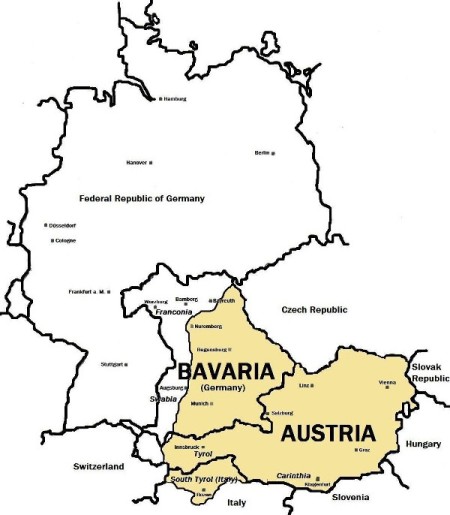

The Freestate of Bavaria and the Republic of Austria.
The areas where the Austro-Bavarian dialects are spoken are highlighted.
Simeon was Jacob’s second son. Simeon’s mother was Leah, and his older brother was Reuben. Speaking of Leah, the Scriptures says: “And she conceived again, and bare a son; and said, Because the LORD hath heard that I was hated, he hath therefore given me this son also: and she called his name Simeon.” (Genesis 29:33)
The name Simeon means “hearing” (Strong’s no. 8095).
Leah’s third son was Levi, who Simeon would be closely attached to. The tribe of Levi is the Swabian-Alemannic Germans in south-west Germany and the German-speaking part of Switzerland.
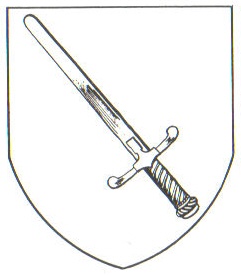
Symbol of the tribe of Simeon: a Sword
(from W.H. Bennett: Symbols of Our Celto-Saxon Heritage (1976), p. 37)
Before Jacob passed away, he told his sons what would befall them in the last days. Simeon and Levi were included in the same description: “Simeon and Levi are brethren; instruments of cruelty are in their habitations. O my soul, come not thou into their secret; unto their assembly, mine honour, be not thou united: for in their anger they slew a man, and in their selfwill they digged down a wall. Cursed be their anger, for it was fierce; and their wrath, for it was cruel: I will divide them in Jacob, and scatter them in Israel.” (Genesis 49:5-7)
Looking back, Jacob said these words with Simeon’s and Levi’s massacre in Shechem in mind (Genesis chap. 34). As a prophecy, however, these words were fulfilled in Adolf Hitler, who was born in Austria, and the National Socialist movement, which originated in Bavaria. No-one has done more to invoke the world’s hatred against White Christendom than Hitler and the National Socialist movement.
Just before the 12 tribes of Israel entered into Canaan to possess it, Moses gave each of the tribes a blessing (Deuteronomy chap. 33). The tribe of Simeon, however, was the only tribe which did not get a blessing before entering into the Promised land.
What Simeon had done with Levi in Shechem was not just bad. It was very bad.
(The tribe of Levi redeemed Levi the patriarch’s share in this misdeed when the rest of the tribes of Israel were dancing around the golden calf. On Moses’ command, the tribe of Levi slew 3,000 fellow-Israelites (Exodus 32:25-29).)
Simeon had six sons: “And the sons of Simeon; Jemuel, and Jamin, and Ohad, and Jachin, and Zohar, and Shaul the son of a Canaanitish woman.” (Genesis 46:10)
The Holy Scriptures do not mention the nationality of Simeon’s first wife, only that his second wife was a Canaanite. But according to the Book of Jasher, Simeon’s first wife was his own sister Dinah!
Speaking of Reuben, the Book of Jasher says: “… and Simeon his brother took his sister Dinah for a wife, and she bare unto him Memuel, Yamin, Ohad, Jachin and Zochar, five sons. And he afterward came to Bunah the Canaanitish woman, the same is Bunah whom Simeon took captive from the city of Shechem, and Bunah was before Dinah and attended upon her, and Simeon came to her, and she bare unto him Saul.” (Book of Jasher 45:2-3)
(The Book of Jasher is unique, because while it is not a part of the Holy Scriptures, it is referred to twice in the Holy Scriptures, in Joshua 10:13 and 2 Samuel 1:18.)
The names of Simeon’s six sons mean:
Dinah’s sons:
Jemuel: “day of God” (Strong’s no. 3223)
Jamin: “the right hand or side (leg, eye) of a person” (Strong’s no. 3226)
Ohad: “to be united” (Strong’s no. 161)
Jachin: “he (or it) will establish” (Strong’s no. 3199)
Zohar: “whiteness” (Strong’s no. 6714)
Bunah’s son:
Shaul: “asked (the passive part)” (Strong’s no. 7586)
The Simeonites of Bunah’s lineage were numbered alongside the Simeonites of Dinah’s lineage (see Numbers 26:12-14).
The Bavarians are an ethnic entity, a tribe. Most, but not all, of the Freestate of Bavaria is populated by ethnic Bavarians. West Bavaria is inhabited by Swabians, and north-west Bavaria by Franks. They are all different German ethnic entities, tribes.
The Austrians are a German-speaking nationality. Ethnically, the Austrians are a branch of the Bavarians.
The Bavarians are believed to have their name from the Celtic tribe the Boii, which also gave name to Bohemia. In 16-15 BC the Romans annexed territories where the Celtic Boii lived, and let several Germanic tribes be stationed there. These amalgamated into the Bavarians who spoke a German dialect.
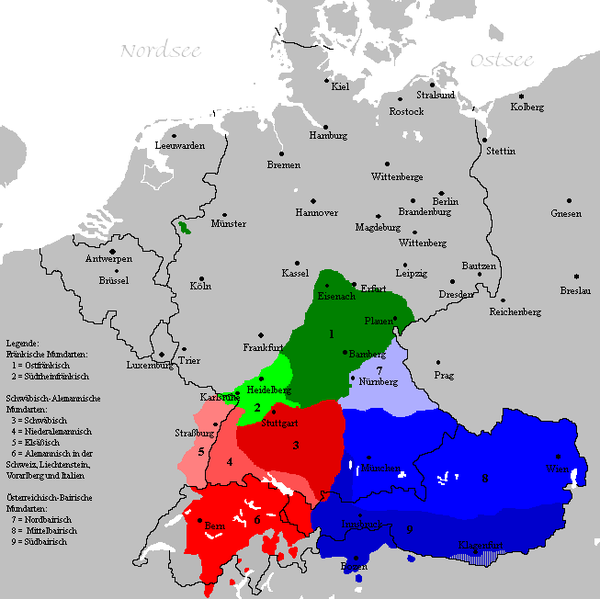
High German dialects.
Austro-Bavarian dialects are in blue colours:
North Bavarian (7), Central or Danube Bavarian (8), and South Bavarian (9).
Swabian-Alemannic dialects are in red colours.
Two Franconian dialects are in green colours.
(Courtesy Wikipedia.)
Austro-Bavarian, or simply Bavarian, is today a group of High German dialects. They are spoken in most of Bavaria, except in the west and north-west, and in virtually all of Austria, and in South Tyrol in Italy. The three Austro-Bavarian dialects do not follow political borders.
When Austria entered the European Union in 1995, Austria unsuccessfully tried to get Austrian recognized as a separate language. The differences between the High German dialects and North and Middle German dialects are often exaggerated.
Bavaria’s population is 67% Catholic and 24% Lutheran. Bavaria proper, i.e. the mid and south-east part of the Freestate of Bavaria where the ethnic Bavarians live, is among Germany’s most Catholic areas. The Lutherans predominates in Franconia in north-west Bavaria, where the population ethnically not are Bavarians, but Franks.
Austria’s population is 68.5% Catholic and 4.7% Protestant. The Protestants are concentrated in the Carinthia province in south Austria.
Jesus built His church on Simon Peter (Matthew 16:18-19), who was a representative of the tribe of Simeon. The Roman Catholic Church claims to be the successor to Simon Peter. It is therefore no wonder that the Bavarians and Austrians are predominantly Catholic.
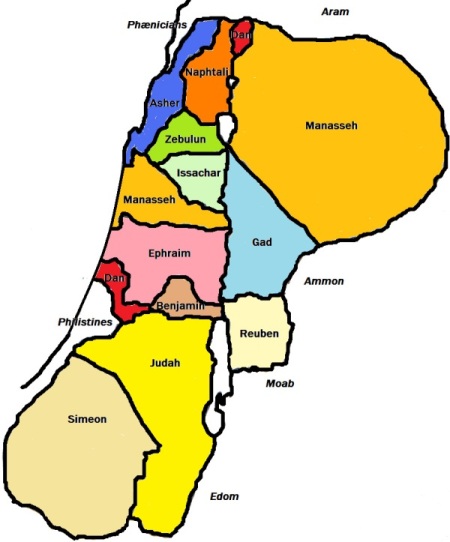
The 12 tribes of Israel in Canaan.
In Canaan of old, the tribe of Simeon was the Israelite tribe which lived farthest to the south. Likewise, Bavaria and Austria are farthest to the south of the Nordic, Germanic, and Anglo-Saxon nations in Europe.
A major town in the land of Simeon was Beersheba. The Biblical expression “from Beersheba even to Dan” (in 1st and 2nd Chronicles) and “from Dan even to Beersheba” (in the books of Judges and 1st and 2nd Samuel) indicated the two extremes of the 12 tribes. Beersheba in Simeon’s territory was farthest to the south, and Dan in Dan’s territory was farthest to the north.
In Canaan, Joshua gave the tribe of Simeon a piece of land which actually was a part of Judah’s inheritance: ”Out of the portion of the children of Judah was the inheritance of the children of Simeon: for the part of the children of Judah was too much for them: therefore the children of Simeon had their inheritance within the inheritance of them.” (Joshua 19:9)
Simeon lived in Judah’s territory. Likewise, Bavaria is a part of Germany.
The racial elements of Bavaria and Austria were described in details by the German race scientist Dr. Hans F.K. Günther (1891-1968), who taught at three different universities, in The Racial Elements of European History (1927).
The strain of the Nordic race is rather weak in Bavaria and Austria. In Bavaria and Austria the predominant race is the Dinaric race:
“It is the whole region of the Bavarian dialect which shows the strongest element of Dinaric race. In south Bavaria and Austria what we find is a predominance of this race – a predominance which grows more and more decided as we near the south-eastern border of the German-speaking area.” (Hans F.K. Günther: The Racial Elements of European History, Chapter VI Part One)
Dr. Günther describes the Dinaric race as follows:
“The Dinaric race: tall, short-headed, narrow-faced, with a steep back to the head, looking as though it were cut away; very prominent nose, which stands right out, with a high bridge, and at the cartilage sinks downward at its lower part, becoming rather fleshy; curly brown or black hair; deep-sunk brown eyes, standing out; brownish skin.” (ibid., Chap. I)
Simeon the patriarch had six sons, five of them with his wife and sister DINAH (Book of Jasher 45:2-3). This is fulfilled in that the DINARIC race is the predominant racial strain in the Bavarians and Austrians.
Note that when “races” are mentioned in this context, it is different White races that is meant.
Note that the Israelite tribes of Old Testament times were racially related, but they were not racially identical. Even the 12 patriarchs took spouses of diverse nationalities.
Also note that when different nationalities are mentioned in the Bible (Israelites, Moabites, Phænicians, etc.), they are nationalities and not races. Each nationality, however, no doubt had its distinct racial strains.
The Swiss genetic research institute iGENEA showed in 2008 the distribution of indigenous peoples’ DNA in modern European peoples.
Germans are genetically 45% Celtic, 35% Germanic, 20% Slavonic, and 10% Jewish.
Austrians are genetically 35% Germanic, 30% Slavonic, 10% Finno-Ugric, 10% Jewish, 10% Phænician, and 5% Celtic.
In September 2008 a team of European geneticists published a “genetic map of Europe”. Germans from Augsburg, Bavaria are genetically (1) closest to Austrians (Tyrol), (2) then to North Germans (Kiel, Holstein), Czechs, Frenchmen (Lyon), the Swiss (Lausanne), (3) then to Hungarians, (4) then to the British (London) and Dutch, (5) then to the Irish, Danes, Norwegians, Swedes, Poles, Yugoslavs, and Spaniards (Barcelona).
On the genetic map, Austrians (from Tyrol) are genetically immediately “south” of the South Germans (Augsburg, Bavaria), just like Tyrol in Austria geographically is immediately south of Augsburg, Bavaria. Austrians are genetically (1) closest to the Swiss (Lausanne), (2) then to South Germans (Augsburg, Bavaria), (3) then to Frenchmen (Lyon), (4) then to Hungarians and Czechs.
The genetic map of Europe looks much like the geographical map of Europe. Italians, however, are an exception. They are genetically farther from South Germans and Austrians than they are geographically.
Also in 2008, a group of American, Spanish, Italian, and Swedish researchers made a graph illustrating the genes of Europeans and Ashkenazi Jews. This showed that Germans genetically are (1) closest to the Dutch, then (2) to the British and Scandinavians, and then (3) to the Irish. This group of North European peoples genetically made up a group. The Germans are genetically farther from (4) the Spanish and (5) Italians, and farthest from (6) Greeks and Ashkenazi Jews. The group of South European peoples also made up a genetic group. The Ashkenazi Jews made up a separate genetic group, equally far from the North European group and the South European group. 1
In 16-15 BC the Roman Empire annexed areas where the Celtic tribe the Boii lived, and turned them into the provinces Rætia (roughly corresponding to Bavaria) and Noricum (roughly corresponding to Austria).
The Celtic Boii and several Germanic tribes amalgamated into the Bavarians.
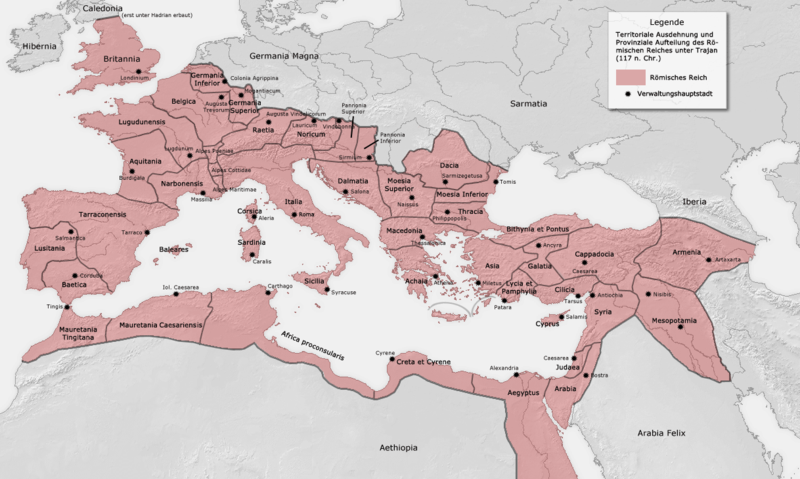
The Roman Empire under Emperor Trajan (117 AD). Notice the Imperial province Rætia and the senatorial province Noricum. (Courtesy Wikipedia.)
After the collapse of the Roman Empire, the Bavarians came under domination by the Franks, another Germanic tribe. The Franks used the Bavarians as a buffer zone from peoples from the east, such as Slavs and Avars. Around 550 AD the Bavarians were put under a duke who acted as governor under the king of the Franks. Under Theodo duke of Bavaria (625-716 AD), the Bavarians achieved de facto independence from the Franks, but under Charles Martel king of the Franks (ruler 714-741), the Bavarians were again laid under the king of the Franks.
Already under Theodo, the bulk of the Bavarians professed Christianity.
In 817 AD the Frankish Empire was divided, and Bavaria was one of the territories given to Louis (Ludwig) the German king of the East Franks. (East Francia evolved into Germany, while West Francia evolved into France.) Bavaria continued being a defence against incoming peoples from the east, and in 907 AD almost the whole Bavarian tribe is said to have perished in the Battle of Pressburg (today: Bratislava) against the incoming Hungarians.
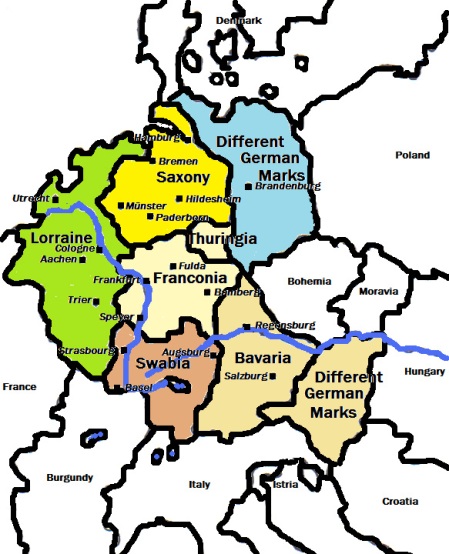
The tribal duchies which made up Germany 919-936 under Henry I the Fowler, duke of Saxony, king of the Germans: Franconia (Franks), Bavaria (Bavarians), Swabia (Swabians and Alemannians), Saxony (Saxons), and Lorraine (Lothringen, which was not a tribal duchy)
In 745 AD, while Bavaria was under the king of the Franks, Odilo duke of Bavaria subdued the Slavonic principality of Carinthia (roughly corresponding to modern Austria). In 899 AD Carinthia was turned into a “mark” under the East Frankish Empire.
A central in event in Simeon the patriarch’s life was the massacre at Shechem, described in Genesis chap. 34. The Book of Jasher additionally describes this event with many more details.
The massacre in Shechem was prophetically fulfilled in Nazi Germany and the Holocaust, where the Nazis were motivated by much the same motives as Simeon was, and did much the same things as Simeon did in Genesis chap. 34.
When Dinah, Jacob’s daughter, was visiting the Canaanite daughters, she was abducted by the local Canaanite prince Shechem, who raped her and insisted on marrying Dinah. (The details in the Book of Jasher makes it perfectly clear that this was not a romance.) Shechem’s father Hamor said to Jacob: “And make ye marriages with us, and give your daughters unto us, and take our daughters unto you. And ye shall dwell with us: and the land shall be before you; dwell and trade ye therein, and get you possessions therein.” (Genesis 34:8-10) In today’s language, Hamor said to Jacob that he wanted the Israelites to integrate with the Canaanites.
The Israelites then made up a plan, and answered the Canaanites that they would only agree to their proposal if the Canaanites were circumcised. According to the Book of Jasher, this plan was actually Simeon’s (Book of Jasher 33:37). When the Canaanites lay sick after their circumcision, Simeon and Levi killed all the males, and all females who were not virgins: “And it came to pass on the third day, when they were sore, that two of the sons of Jacob, Simeon and Levi, Dinah’s brethren, took each man his sword, and came upon the city boldly, and slew all the males. And they slew Hamor and Shechem his son with the edge of the sword, and took Dinah out of Shechem’s house, and went out. The sons of Jacob came upon the slain, and spoiled the city, because they had defiled their sister.” (Genesis 34:25-26)
One of the Canaanite virgins which Simeon and Levi took prisoners was Bunah, who became Simeon’s second wife: “And the number of women whom Simeon and Levi took captives from the city of Shechem, whom they did not slay, was eighty-five who had not known man. And amongst them was a young damsel of beautiful appearance and well favoured, whose name was Bunah, and Simeon took her for wife…” (Book of Jasher 34:36)
Jacob was very displeased with this, and said to Simeon and Levi: “Ye have troubled me to make me stink among the inhabitants of the land, among the Canaanites and the Perizzites: and I being few in number, they shall gather themselves together against me, and slay me; and I shall be destroyed, I and my house.” (Genesis 34:30)
The Canaanites and Amorites who lived in other cities raised an army of 10,000 men, but they were stricken with terror because of Isaac’s and Jacob’s intercessory prayers (Book of Jasher 35:1-2).
Six years later, the Canaanites and Amorites again decided to fight the Israelites, but instead the sons of Jacob killed more than 15,000 of them (Book of Jasher chap. 37).
The survivors of the Canaanite and Amorite armies then fled to the nearby Canaanite city CHAZAR, where the sons of Jacob again smote the Canaanites and Amorites. Simeon took a very active rôle in this massacre (Book of Jasher chap. 38:1-18).
After additional defeats, the Canaanite kings asked for peace, which the sons of Jacob granted them (Book of Jasher chap. 38-40).
Most modern Jews descend from the Turkic people the KHAZARS, which had a huge kingdom in south Russia. In the 8th century AD most of the Khazars converted to Judaism. The majority of modern Jews descend from the Khazars.
Not only does Simeon’s and Levi’s massacre in Shechem and Chazar have a similarity with the Holocaust, but the primary victims of the Holocaust were the Khazar Jews!
Speaking of the Khazar Jews and the Holocaust, Arthur Koestler - himself a Khazar Jew - wrote: “If so, this would mean that their ancestors came not from the Jordan but from the Volga, not from Canaan but from the Caucasus, once believed to be the cradle of the Aryan race; and that genetically they are more closely related to the Hun, Uigur and Magyar tribes than to the seed of Abraham, Isaac and Jacob. Should this turn out to be the case, then the term ‘anti-Semitism’ would become void of meaning, based on a misapprehension shared by both the killers and their victims.” (Arthur Koestler: The Thirteenth Tribe, p. 17)
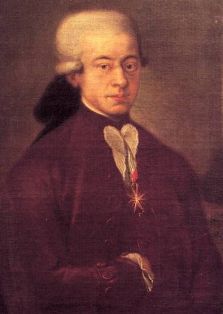 |
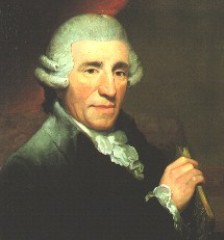 |
Left: Wolfgang Amadeus Mozart (1756-1791) (Painted by an unknown painter in 1777. Public domain.)
Right: Joseph Haydn (1732-1809) (Painted by Thomas Hardy in 1792. Public domain.)
The hot-headed and fiery spirit of the tribe of Simeon is expressed in Mozart’s and Haydn’s music.
Mozart was born in Salzburg on the Austrian side of the Austro-Bavarian border.
Haydn was born in a village east of Vienna near the Hungarian border.
The tribe of Simeon has characteristics in common with the tribe of Manasseh, but is at the same time also often found in opposition to Manasseh in particular and Joseph in general.
In Jacob’s blessing to Ephraim and Manasseh, Joseph’s sons, there is a parallel between Manasseh and Simeon. Speaking to Joseph, Jacob said: “And now thy two sons, Ephraim and Manasseh, which were born unto thee in the land of Egypt before I came unto thee into Egypt, are mine; as Reuben and Simeon, they shall be mine.” (Genesis 48:5, my underlining)
When the sons of Israel first chose to kill Joseph (Gen. 37), who became Manasseh’s father, it was, according to the Book of Jasher, Simeon’s idea. They changed the plan, however, when Judah suggested that they sold Joseph instead for 20 pieces of silver.
“And Simeon said to his brethren, Behold the man of dreams is coming unto us this day, and now therefore come and let us kill him and cast him in one of the pits that are in the wilderness, and when his father shall seek him from us, we will say an evil beast has devoured him.” (Book of Jasher 41:25)
When the 10 sons of Israel came to buy corn in Egypt, where Joseph had become governor, Joseph demanded that they brought Benjamin with them to Egypt as well. Joseph sent 9 of the brothers back to Canaan, and imprisoned Simeon (in Egypt). Speaking of Joseph, the Scripture says: “And he turned himself about from them, and wept; and returned to them again, and communed with them, and took from them Simeon, and bound him before their eyes.” (Genesis 42:24) In the Book of Jasher there are some interesting details which are not mentioned in the Holy Scriptures, namely that it was Manasseh personally who bound up Simeon:
“And Joseph called unto his mighty men and seventy valiant men came before him with drawn swords in their hands, and the sons of Jacob were terrified at them. And Joseph said unto them, Seize this man and confine him in prison until his brethren come to him, and Joseph’s valiant men hastened and they all laid hold of Simeon to bind him, and Simeon gave a loud and terrible shriek and the cry was heard at a distance. And all the valiant men of Joseph were terrified at the sound of the shriek, and they fell upon their faces, and they were greatly afraid and fled. And all the men that were with Joseph fled, for they were greatly afraid of their lives, and only Joseph and Manasseh his son remained there, and Manassah the son of Joseph saw the strength of Simeon, and he was exceedingly wroth. And Manassah the son of Joseph rose up to Simeon, and Manassah smote Simeon a heavy blow with his fist against the back of his neck, and Simeon was stilled of his rage. And Manassah laid hold of Simeon and seized him violently and he bound him and brought him into the house of confinement, and all the sons of Jacob were astonished at the act of the youth. And Simeon said unto his brethren, None of you must say that this is the smiting of an Egyptian, but it is the smiting of the house of my father.” (Book of Jasher 51:38-44)
Simeon’s and Manasseh’s common characteristics and their opposition can be seen in WWII, when Nazi Germany – which was headed by an Austro-Bavarian and whose ideology started in Bavaria – in effect was overcome by America’s strength.
Following WWII, several of the Western Allies wanted a large-scale revenge and retribution against Germany. The Netherlands, for example, wanted to annex a large part of Lower Saxony. America, however, insisted that Germany was treated decently.
When Germany was occupied 1945-49, the American occupation zone included Bavaria and a part of Austria.
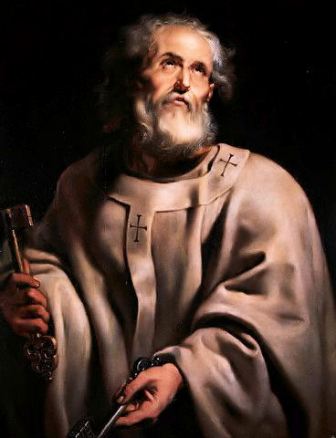
The apostle Simon Peter. (Painted by Peter Paul Rubens (1577-1640). Public domain)
In the Old Testament, the tribe of Simeon lived in a territory which was a part of Judah’s territory. Likewise Simon Peter was Jesus’ right hand. Simon Peter was the apostle of the tribe of Simeon, and the Lord Jesus Christ was of the tribe of Judah. (Compare Judges 1:1-3.)
Simeon the patriarch had committed a terrible act by taking up the sword when he and Levi slew (more than) the Canaanite town Shechem to protect their sister Dinah.
The apostle Simon Peter also picked up the sword when Jewish leaders and Judas Iscariot came with soldiers to arrest Jesus, as it is written: “Then came they, and laid hands on Jesus, and took him. And, behold, one of them which were with Jesus stretched out his hand, and drew his sword, and struck a servant of the high priest’s, and smote off his ear. The said Jesus unto him, Put up again thy sword into his place: for all they that take the sword shall perish with the sword.” (Matthew 26:50-52)
Unlike Simeon the patriarch, Simon Peter repented and abstained from killing with the sword. Thus Simon Peter redeemed Simeon the patriarch’s acts. (Likewise, Jesus redeemed Judah the patriarch’s less-than-perfect acts.)
When the 12 tribes of Israel entered Canaan to possess it, Simeon was the least blessed of the tribes, being the only tribe without a blessing (Deuteronomy chap. 33). When the 12 apostles went out to preach the Gospel of Christ to the world, Simon Peter was the most blessed of the apostles, being the apostle upon whom Christ would build His church (Matthew 16:16-19).
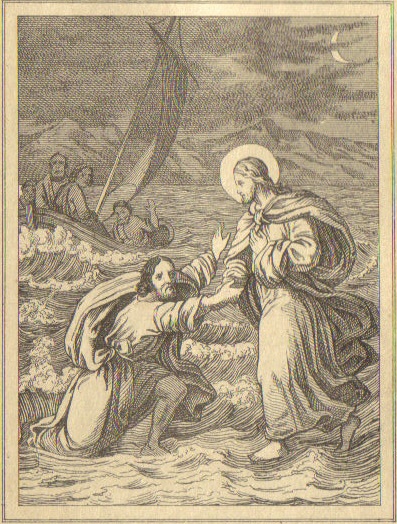
Jesus and Simon Peter walk on the lake. Simon Peter sinks, and Jesus stretches out His hand and catches him (Matthew 14:30-31). Jesus Christ and Simon Peter illustrate the relationship between the tribe of Judah and the tribe of Simeon.
Simeon the patriarch was a fervent Israelite nationalist. Likewise, Simon Peter was a Christian Israelite nationalist who had no intentions about preaching the Gospel to non-Israelites. But the Spirit of God showed Simon Peter in a vision that he should call no man or nationality unclean (Acts chap. 10). Simon Peter was then led to Cornelius, a Roman centurion, to whom Simon Peter said: “Ye know how that it is an unlawful thing for a man that is a Jew to keep company, or come unto one of another nation; but God hath shewed that I should not call any man common or unclean.” (Acts 10:28)
Simon Peter then preached to Gospel to all nationalities, and that would also mean all races. Still, Simon Peter mainly preached to Jews. It was Paul who became the apostle to the non-Jews, as Paul wrote of himself and Simon Peter: “(For he that wrought effectually in Peter to the apostleship of the circumcision, the same was mighty in me toward the Gentiles:) and when James, Cephas, and John, who seemed to be pillars, perceived the grace that was given unto me they gave to me and Barnabas the right hands of fellowship; that we should go unto the heathen, and they unto the circumcision.” (Galatians 2:7-8)
“The circumcision” in this context meant the Jews of those days, because they were the only ones who remained under the old Mosaic Covenant of circumcision. “The uncircumcision” in this context meant all non-Jews, both Israelites of the lost tribes and all non-Israelite nationalities on earth.
Adolf Hitler can be compared to Simeon the patriarch. Hitler was born in 1889 in Braunau am Inn, on the Austrian side of Austro-Bavarian border. Hitler represents the tribe of Simeon in its unacceptable state.
Pope Benedict XVI can be compared to the apostle Simon Peter. Pope Benedict was born (as Joseph Ratzinger) in 1927 in Marktl am Inn, on the Bavarian side of the Austro-Bavarian border. Pope Benedict represents the tribe of Simeon in its acceptable state.
December 2008
The Authorized King James Version
The Book of Jasher (J.H. Parry & Company: Salt Lake City, Utah, USA, 1887)
W.H. Bennett: Symbols of Our Celto-Saxon Heritage (Canadian British Israel Association: Windsor, Ontario, Canada, 1976)
Hans F.K. Günther: The Racial Elements of European History (Methuen and Co.: London, UK, 1927)http://www.white-history.com/earlson/hfk/reoehcover.htm
Arthur Koestler: The Thirteenth Tribe (Random House, Inc.: New York, New York, USA, 1976)
Sybille Hildebrandt: Genetisk Europakort: finner og italienere er outsidere (videnskab.dk, 3 September, 2008)
Inma Pazos: Distribution of indigenous peoples in various countries (igenea.com, 2008)
Jonathan K. Pritchard (ed.): Analysis and Application of European Genetic Substructure Using 300 K SNP Information (University of Chicago, USA, 18 January, 2008) http://www.plosgenetics.org/article/info:doi/10.1371/journal.pgen.0040004
1 Jonathan K. Pritchard (ed.): Analysis and Application of European Genetic Substructure Using 300 K SNP Information Click this footnote's number to return to where you were in the text.